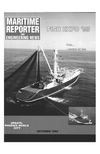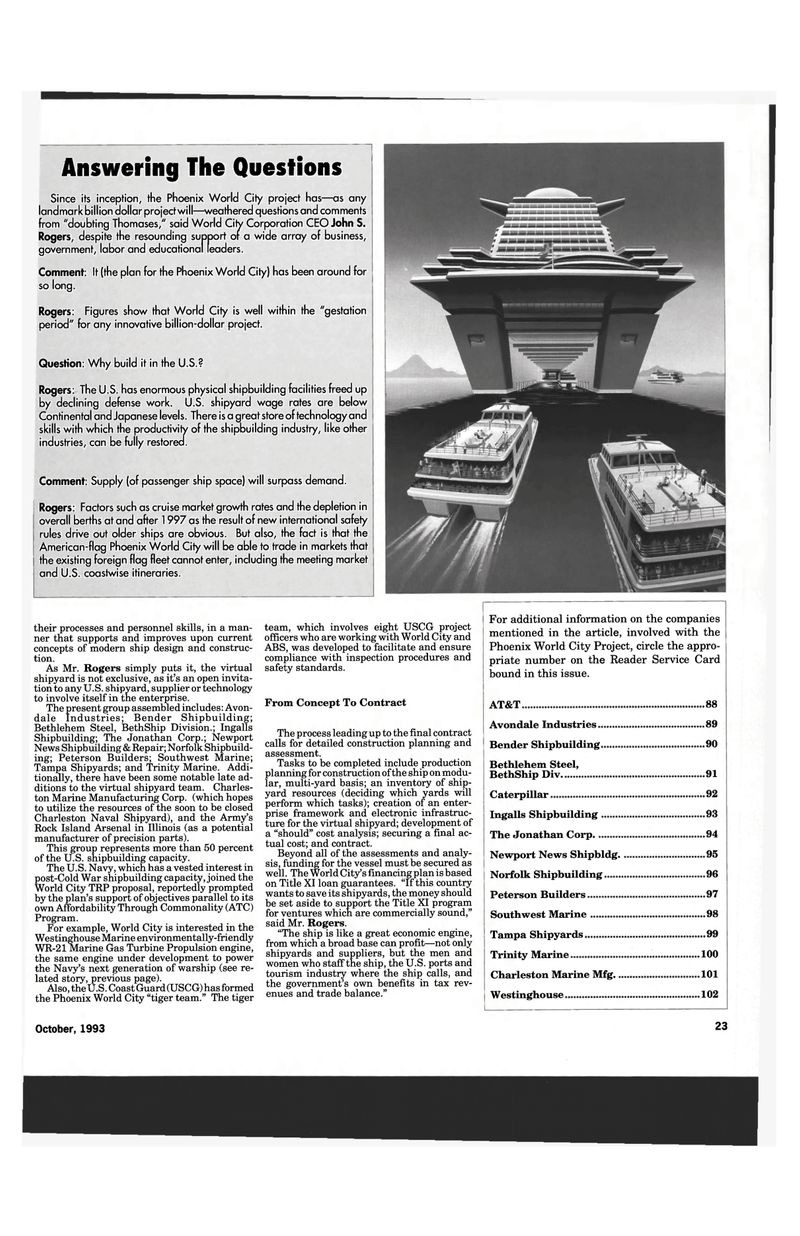
Page 21: of Maritime Reporter Magazine (October 1993)
Read this page in Pdf, Flash or Html5 edition of October 1993 Maritime Reporter Magazine
Answering The Questions
Since its inception, the Phoenix World City project has—as any landmark billion dollar project will—weathered questions and comments from "doubting Thomases," said World City Corporation CEO John S.
Rogers, despite the resounding support of a wide array of business, government, labor and educational leaders.
Comment: It (the plan for the Phoenix World City) has been around for so long.
Rogers: Figures show that World City is well within the "gestation period" for any innovative billion-dollar project.
Question: Why build it in the U.S.?
Rogers: The U.S. has enormous physical shipbuilding facilities freed up by declining defense work. U.S. shipyard wage rates are below
Continental and Japanese levels. There is a great store of technology and skills with which the productivity of the shipbuilding industry, like other industries, can be fully restored.
Comment: Supply (of passenger ship space) will surpass demand.
Rogers: Factors such as cruise market growth rates and the depletion in overall berths at and after 1997 as the result of new international safety rules drive out older ships are obvious. But also, the fact is that the
American-flag Phoenix World City will be able to trade in markets that the existing foreign flag fleet cannot enter, including the meeting market and U.S. coastwise itineraries. their processes and personnel skills, in a man- ner that supports and improves upon current concepts of modern ship design and construc- tion.
As Mr. Rogers simply puts it, the virtual shipyard is not exclusive, as it's an open invita- tion to any U.S. shipyard, supplier or technology to involve itself in the enterprise.
The present group assembled includes: Avon- dale Industries; Bender Shipbuilding;
Bethlehem Steel, BethShip Division.; Ingalls
Shipbuilding; The Jonathan Corp.; Newport
News Shipbuilding & Repair; Norfolk Shipbuild- ing; Peterson Builders; Southwest Marine;
Tampa Shipyards; and Trinity Marine. Addi- tionally, there have been some notable late ad- ditions to the virtual shipyard team. Charles- ton Marine Manufacturing Corp. (which hopes to utilize the resources of the soon to be closed
Charleston Naval Shipyard), and the Army's
Rock Island Arsenal in Illinois (as a potential manufacturer of precision parts).
This group represents more than 50 percent of the U.S. shipbuilding capacity.
The U.S. Navy, which has a vested interest in post-Cold War shipbuilding capacity, joined the
World City TRP proposal, reportedly prompted by the plan's support of objectives parallel to its own Affordability Through Commonality (ATC)
Program.
For example, World City is interested in the
Westinghouse Marine environmentally-friendly
WR-21 Marine Gas Turbine Propulsion engine, the same engine under development to power the Navy's next generation of warship (see re- lated story, previous page).
Also, the U.S. Coast Guard (USCG) has formed the Phoenix World City "tiger team." The tiger team, which involves eight USCG project officers who are working with World City and
ABS, was developed to facilitate and ensure compliance with inspection procedures and safety standards.
From Concept To Contract
The process leading up to the final contract calls for detailed construction planning and assessment.
Tasks to be completed include production planning for construction of the ship on modu- lar, multi-yard basis; an inventory of ship- yard resources (deciding which yards will perform which tasks); creation of an enter- prise framework and electronic infrastruc- ture for the virtual shipyard; development of a "should" cost analysis; securing a final ac- tual cost; and contract.
Beyond all of the assessments and analy- sis, funding for the vessel must be secured as well. The World City's financing plan is based on Title XI loan guarantees. "If this country wants to save its shipyards, the money should be set aside to support the Title XI program for ventures which are commercially sound," said Mr. Rogers. "The ship is like a great economic engine, from which a broad base can profit—not only shipyards and suppliers, but the men and women who staff the ship, the U.S. ports and tourism industry where the ship calls, and the government's own benefits in tax rev- enues and trade balance."
For additional information on the companies mentioned in the article, involved with the
Phoenix World City Project, circle the appro- priate number on the Reader Service Card bound in this issue.
AT&T 88
Avondale Industries 89
Bender Shipbuilding 90
Bethlehem Steel,
BethShip Div 91
Caterpillar 2
Ingalls Shipbuilding 93
The Jonathan Corp 4
Newport News Shipbldg 95
Norfolk Shipbuilding 96
Peterson Builders 7
Southwest Marine 98
Tampa Shipyards 9
Trinity Marine 100
Charleston Marine Mfg 101
Westinghouse 102
October, 1993 23

 20
20

 22
22
